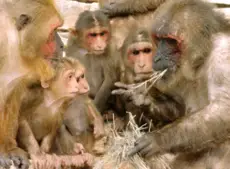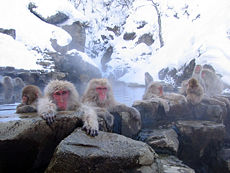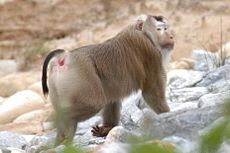Difference between revisions of "Macaque" - New World Encyclopedia
Rick Swarts (talk | contribs) |
Rick Swarts (talk | contribs) |
||
| Line 75: | Line 75: | ||
* Carroll, S. B. 2006. ''The Making of the Fittest''. W.W. Norton and Company. ISBN 9780393061635. | * Carroll, S. B. 2006. ''The Making of the Fittest''. W.W. Norton and Company. ISBN 9780393061635. | ||
| + | |||
| + | * Primate Info Net (PIN). http://pin.primate.wisc.edu/factsheets/links/macaca. | ||
| + | |||
| + | |||
| + | |||
| + | San Diego Zoo. http://www.sandiegozoo.org/animalbytes/t-monkey.html | ||
| + | |||
| + | Shidler, S. L. n.d. | ||
| + | http://www.primate.wisc.edu/wprc/pdfs/Macaque.pdf | ||
== External links == | == External links == | ||
Revision as of 16:25, 28 June 2008
- This article is about the monkey. For the racial slur, see Macaca (slur).
| Macaques[1] | ||||||||||||||
|---|---|---|---|---|---|---|---|---|---|---|---|---|---|---|
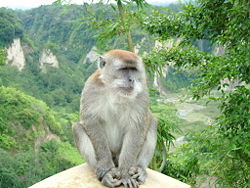 Crab-eating macaque (Macaca fascicularis)
| ||||||||||||||
| Scientific classification | ||||||||||||||
| ||||||||||||||
| Simia inuus Linnaeus, 1758 = Simia sylvanus Linnaeus, 1758 | ||||||||||||||
|
See text. |
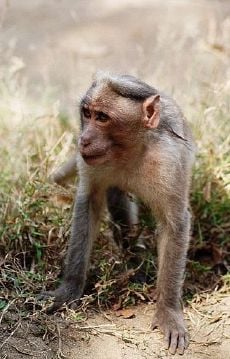
The macaques (pronounced /məˈkæk/) constitute a genus (Macaca, /məˈkækə/) of Old World monkeys of the subfamily Cercopithecinae.
Aside from humans (genus Homo), the macaques are the most widespread primate genus, ranging from northern Africa to Japan. Twenty-two macaque species are currently recognised, and they include some of the monkeys best known to non-zoologists, such as the Rhesus Macaque (as the Rhesus Monkey), Macaca mulatta, and the Barbary Macaque (as the Barbary Ape), M. sylvanus, a colony of which lives on the Rock of Gibraltar. Although several species lack tails, and their common names therefore refer to them as apes, these are true monkeys, with no greater relationship to the true apes than any other Old World monkeys.
Several species of macaque are used extensively in animal testing.
In the late 1990s it was discovered that nearly all (circa 90%) pet or captive macaques are carriers of the herpes-B virus. This virus is harmless to macaques, but infections of humans, while rare, are potentially fatal. A 2005 University of Toronto study showed that urban performing macaques also carried simian foamy virus, suggesting they could be involved in the species-to-species jump of similar retroviruses to humans.[2]
Characteristics
An Old World monkey is any member of the primate family Cercopithecidae of the superfamily Cercopithecoidea in the clade Catarrhini, typically characterized by close-set nostrils that are downward or forward facing, a tubular ear bone, and a tail, if present, that is never prehensile (adapted for grasping or holding).
The scientific name for the New World monkeys, Platyrrhini, means "flat nosed." The noses of New World monkeys are flatter than the narrow noses of the Old World monkeys, and New World monkeys have side facing nostrils versus the close-set, downward or forward facing nostrils of Old World monkeys. Also New World monkeys (except for the howler monkeys of genus Alouatta (Jacobs et al. 1996)) lack the trichromatic vision of Old World monkeys (Carroll 2006). Other distinctions include the presence of a tubular ectotympanic (ear bone) in Old World monkeys and the presence of twelve premolars in catarrhines, versus eight in platyrrhines. The dental formula of catarrhines is:
| 2.1.2.3 |
| 2.1.2.3 |
From the point of view of superficial appearance, Old World monkeys are unlike apes in that most have tails. All living members of the apes are tailless. However, there are also primates in other families that lack tails and some Old World monkey species lack tails. More specifically, the apes can be distinguished from Old World monkeys by the number of cusps on their molars: apes have five, the "Y-5" molar pattern, while Old World monkeys have only four in a "bilophodont" pattern.
Two subfamilies of Old World monkeys are recognized, Cercopithecinae and Colobinae. The cercopithecines are mainly African but include the diverse genus of macaques, which are Asian and North African. This group also includes baboons and mandrills, among others. The colobines includes most of the Asian genera but also the African colobus monkeys. Langurs and proboscis monkeys are among those included in Colobinae.
Species list
Genus Macaca
- M. sylvanus group
- Barbary Macaque, Macaca sylvanus
- M. nemestrina group
- Lion-tailed Macaque, Macaca silenus
- Southern Pig-tailed Macaque or Beruk, Macaca nemestrina
- Northern Pig-tailed Macaque, Macaca leonina
- Pagai Island Macaque, Macaca pagensis
- Siberut Macaque, Macaca siberu
- Moor Macaque, Macaca maura
- Booted Macaque, Macaca ochreata
- Tonkean Macaque, Macaca tonkeana
- Heck's Macaque, Macaca hecki
- Gorontalo Macaque, Macaca nigriscens
- Celebes Crested Macaque, Macaca nigra
- M. fascicularis group
- Crab-eating Macaque, Macaca fascicularis
- Stump-tailed Macaque, Macaca arctoides
- M. mulatta group
- Rhesus Macaque, Macaca mulatta
- Formosan Rock Macaque, Macaca cyclopis
- Japanese Macaque, Macaca fuscata
- M. sinica group
- Toque Macaque, Macaca sinica
- Bonnet Macaque, Macaca radiata
- Assam Macaque, Macaca assamensis
- Tibetan Macaque, Macaca thibetana
- Arunachal Macaque, Macaca munzala
ReferencesISBN links support NWE through referral fees
- ↑ C. Groves, "Order Primates," "Order Monotremata," (and select other orders). Page(s) 161-165 in D. E. Wilson and D. M. Reeder, eds., Mammal Species of the World, 3rd edition, Johns Hopkins University Press (2005). ISBN 0801882214.
- ↑ University of Toronto - News@UofT - Performing monkeys in Asia carry viruses that could jump species to humans (Dec 8/05)
- Brandon-Jones, D., and T. Rowell. Guenons, macaques, and baboons; Colobus and leaf monkeys. Pages 370-405 in D. W. Macdonald, ed., The Encyclopedia of Mammals. New York: Facts on File. ISBN 0871968711.
- Carroll, S. B. 2006. The Making of the Fittest. W.W. Norton and Company. ISBN 9780393061635.
- Primate Info Net (PIN). http://pin.primate.wisc.edu/factsheets/links/macaca.
San Diego Zoo. http://www.sandiegozoo.org/animalbytes/t-monkey.html
Shidler, S. L. n.d. http://www.primate.wisc.edu/wprc/pdfs/Macaque.pdf
External links
- CDC papers on Herpes B in macaques
- Macaque Monkey Brain Atlas
- British Union for the Abolition of Vivisection film about macaques in laboratories, featuring primatologists Dr. Jane Goodall and Dr. Steven Brend
- Primate Info Net Macaca Factsheets
Credits
New World Encyclopedia writers and editors rewrote and completed the Wikipedia article in accordance with New World Encyclopedia standards. This article abides by terms of the Creative Commons CC-by-sa 3.0 License (CC-by-sa), which may be used and disseminated with proper attribution. Credit is due under the terms of this license that can reference both the New World Encyclopedia contributors and the selfless volunteer contributors of the Wikimedia Foundation. To cite this article click here for a list of acceptable citing formats.The history of earlier contributions by wikipedians is accessible to researchers here:
The history of this article since it was imported to New World Encyclopedia:
Note: Some restrictions may apply to use of individual images which are separately licensed.
